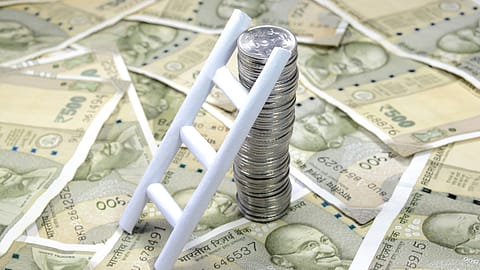Axis Bank expects 7% growth in FY26 amid global uncertainty
H2 FY25 slowdown was driven by unintended fiscal and credit tightening, says an Axis Bank report, adding that the CRR cut should ease growth headwinds

India's economy will likely grow at an above-consensus rate of 7% in FY26, Axis Bank’s chief economist Neelkanth Mishra said today, highlighting key factors supporting the domestic economy. He cited factors like capital formation driven by a capex cycle reboot, tailwinds from back-ended fiscal spending in FY25, the CRR cut, and potential macro-prudential easing to revive credit growth, for optimism around growth.
In the bank’s India Economic and Market Outlook 2025 report, Mishra and co-authors Prateek Ancha, Tanay Dalal, Pulkit Kapoor and Smriti Mehra highlight heightened global uncertainty in trade, elevated interest rates, slowing growth and deflation risks in China, and currency volatility. However, they believe the major drivers of India’s economy getting back to its trend growth rate of 7% remain local.
As per the report, current global growth forecasts show stability, but uncertainty about US policy after 20-Jan cloud visibility. "Uncertainty in global trade and financial markets likely to remain elevated; higher global rates and USDINR volatility likely," says the report.
It highlights that the H2 FY25 slowdown was driven by unintended fiscal and credit tightening. "Fiscal spending is already rising, and the CRR cut should ease growth headwinds arising from a shortage of money."
The economists say the tailwinds from back-ended fiscal spending in FY25, and better credit growth, supported by expected further macro-prudential easing should help the economy reach its potential growth rate of 7% in FY2026.
The global growth in CY25E is currently projected to be unchanged from CY24 at 3.2%, with the trend growth 30-40 bps below pre-Covid levels, says the Axis Bank report. Under the new US President, who has won a mandate to course-correct or disrupt trade, taxes, regulations, immigration and energy among others, policy pronouncements after 20-Jan-25 are key. "Trade tariffs may be ineffective in isolation (fiscal deficits, exchange rates and industrial policy matter too), but can indeed disrupt global trade growth. Global trade growth since 2016 has been driven primarily by the US (imports) and China (exports) post-2016."
The report says neutral rates have risen by more than 1 per cent point across developed economies and may remain well above those seen last decade. "In India, we do not see inflation easing quickly: over the long term, core and food price indices move together. Though food relative to the core, and vegetables relative to food, are both at cyclical highs, the supply response may lag the demand boost from income-transfer schemes."
Recommended Stories
Fiscal spending is already rising and the CRR cut should ease growth headwinds, the report says. "We forecast above-consensus 7% growth in FY26, with capital formation boosted by the restart of the capex cycle and tailwinds from back-ended fiscal spending in FY25, supported by further macro-prudential easing to help re-accelerate credit growth."